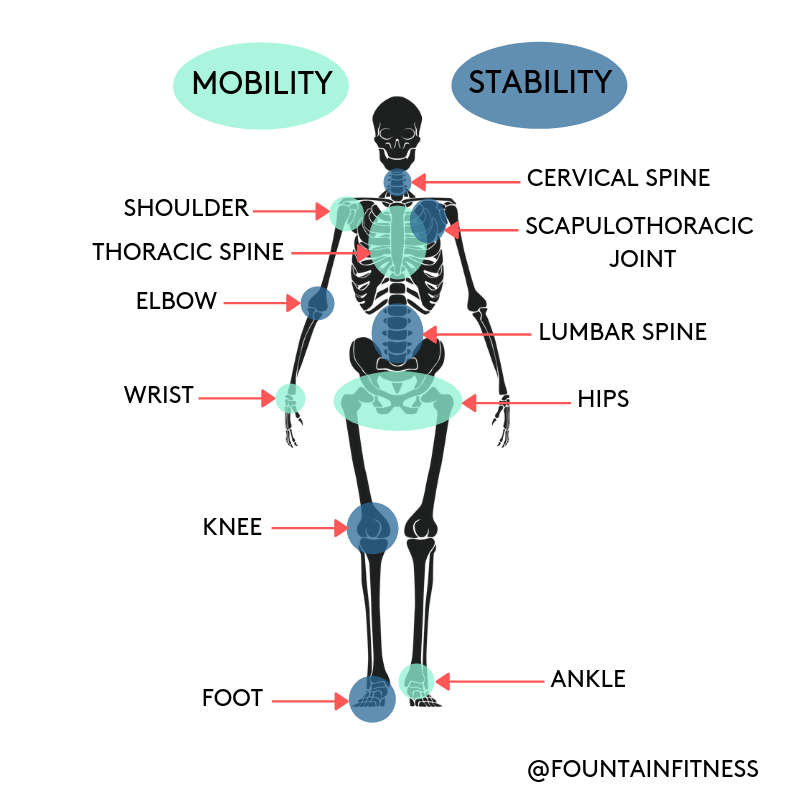
Improve Your Ankle Mobility For Better Squats And Deadlifts
Have you wondered how you can squat and deadlift better? Well, the key could be improving your ankle mobility.
Having adequate ankle mobility will allow you to squat and deadlift better while staying safe and without beating up on your joints.
The ability for your knees to go over your toes (dorsiflexion) while squatting and deadlifting is very important for your ankle health but also for the whole kinetic chain of your body.

As you can see from the graphic above, the ankle is a mobile joint.
If you’re lacking mobility at your ankle, your body will compensate to the joints above and below so you can still move.
Over time, this creates dysfunction, wear and tear, and pain.
It’s very common for a person with immobile ankles to have foot, knee, and/or hip issues.
Why Your Ankles Are Tight
Footwear
Shoes that have elevated heels decrease your ankle mobility.
Wearing shoes with elevated heels is like doing a calf raise every time you take a step. This leads to tight calves and decreased ankle mobility.
Does that mean you can’t wear shoes with raised heels?
No, but this should be limited.
Past Ankle Injuries
Trauma to the ankle from injury is one of the most common causes of reduced ankle mobility.
The body repairs itself from injury by putting scar tissue down which can restrict normal ankle movement.
A bad ankle injury can also affect the alignment of your foot and lower leg bones causing poor ankle mobility and function.
Tight Muscles
We are always on our feet walking, running, and exercising so it makes sense that our muscles will get tight from time to time.
Tight muscles can restrict joint range of motion.
In many cases, it’s all of the above or a combination of the three causes listed above.
What is a good baseline of ankle mobility?
A good baseline of ankle mobility is anywhere from 4-6 inches of dorsiflexion (the ability for the knee to travel over the toe).
Yet, most people don’t start there.
Don’t worry, your ankle mobility can be improved.
How long will it take to improve your ankle mobility?
You could have some instant improvements with your using the exercises below, but it also could take weeks.
Stay consistent with the exercises below to improve it.
How to test your ankle mobility
Did you pass?
Were you able to get 4-6″ from the wall with the above test?
Awesome! You can rest easy that you have enough ankle mobility for your squats and deadlifts!
Did you fail?
If so, let’s figure out why…
Did you feel stiffness in the muscles in the back of the leg?
If so, then you’ll need to improve your lower leg soft tissue quality, stretch, and then mobilize (you can skip the ‘banded ankle mobilization’ and ‘self ankle mobilization’ exercises).
Did you feel a pinch or restriction in front of the ankle?
If so, then you will need everything recommended below.
The 4 Step Process To Improving Your Ankle Mobility
Now that we have tested your ankle mobility, we will use this 4 step approach to improve it…
- Improve Soft Tissue Quality
- Mobilization Exercises
- Stretch
- Maintenance Exercises
1. Improve Soft Tissue Quality
I have yet to meet a person who didn’t have tight calves and who didn’t benefit from performing some self-myofascial release.
So if you didn’t pass the 4-6” baseline, then incorporate some soft tissue work into your routine…
OR
Do this for 1-3 minutes or until you feel your calves/trigger points release.
2. Mobilization Exercises
If you felt a pinch or restriction in the front of your ankle while performing the wall ankle mobility test, then try one or both of these mobilizations.
OR
Do one of these for 1-2 minutes per ankle.
3. Stretch
Now that you have worked on the tissue quality of your calves and mobilized the ankle joint, it’s now time to stretch…
Do this for 1-2 minutes per ankle.
While the gastroc (upper calf) is not responsible for ankle mobility (the soleus is), I’m of the opinion to stretch the calves as a whole.
Do this for 1-2 minutes per ankle.
4. Maintenance Exercises
These mobilizations are great to incorporate into your routine.
They can help improve and keep the ankle mobility you have or have gained.
They are best performed as part of your ankle mobility routine and/or before your workout.
Wall ankle mobilizations
Do 2 sets of 15 reps for each ankle.
Knee-break ankle mobilizations
Do 2 sets of 15 reps.
Squat prying
Do this exercise for 1-2 minutes.
Summary And Recommendations
If you have less than 4-6″ of ankle mobility (determined from the wall ankle mobility test), then you have some work to do.
Do you feel tightness in the back of your leg that limits your ankle range of motion? If so, then do…
- Step 1 – Improve Your Soft Tissue Quality
- Step 3 – Stretch
- Step 4 – Maintenance Exercises
Do you feel a pinch or restriction in the front of your ankle that limits your range of motion? If so, then do…
- Step 1 – Improve Your Soft Tissue Quality
- Step 2 – Mobilization Exercises
- Step 3 – Stretch
- Step 4 – Maintenance Exercises
For each of the above scenarios, my recommendations are best done each time before you work out on your lower body days.
They can also be done on your off days when you have time until your ankle mobility improves.
After that, monitor your ankle mobility occasionally and add in whichever step you may need.
You’re well on your way to improving your squats and deadlifts!
Let me know if you have any questions or how I can help!